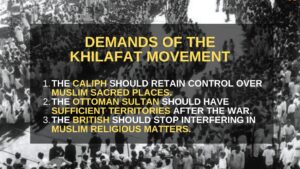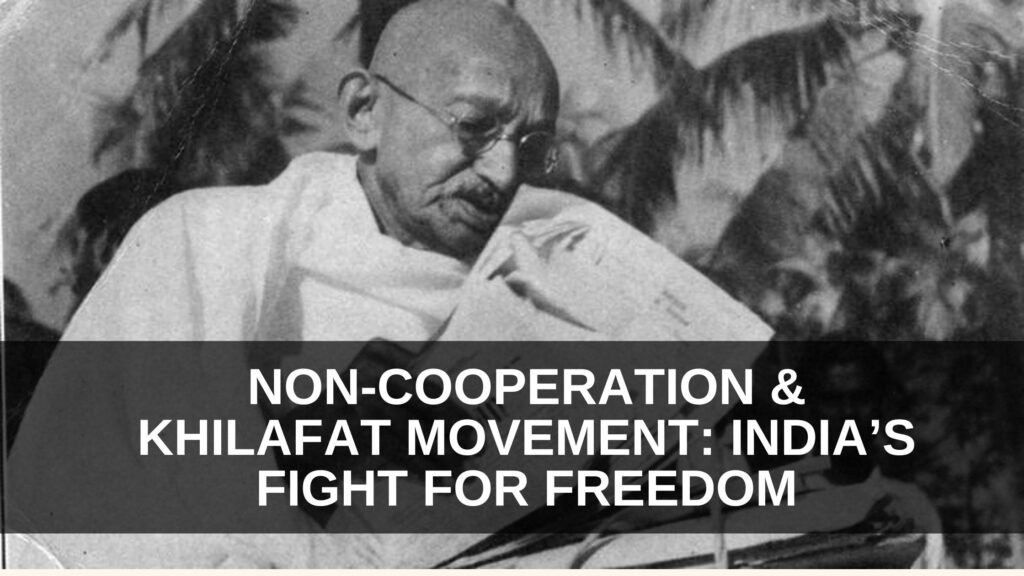The Non Cooperation Movement, launched by Mahatma Gandhi in 1920, was a crucial part of India’s struggle for independence. It aimed at achieving Swaraj (self-rule) by urging Indians to boycott British institutions, foreign goods, and adopt self-reliance.
It was a non-violent mass protest that mobilized millions and laid the foundation for future independence movements. Parallel to this, the Khilafat Movement was launched by Indian Muslims to protest against British actions regarding the Ottoman Caliphate after World War I.
Although the two movements had different objectives, they joined forces to fight against British imperialism, marking an important phase in Hindu-Muslim unity.
Download notes of Swadeshi Movement in India
Background: India Before the Non Cooperation Movement
Several events contributed to the emergence of these movements:
- Hardships due to World War I – Increased taxes, rising prices, and food shortages created economic distress.
- Rowlatt Act (1919) – Allowed imprisonment without trial, causing widespread protests.
- Jallianwala Bagh Massacre (1919) – British troops fired on peaceful protestors, killing hundreds.
- Discontent with Montagu-Chelmsford Reforms (1919) – These reforms failed to meet Indian demands for self-rule.
- Khilafat Issue – Indian Muslims were angered by British actions against the Ottoman Sultan, their religious leader.
These events fueled anti-British sentiments, leading to mass protests.
What was the Non-Cooperation Movement?
The Non-Cooperation Movement (1920-1922) was a large-scale movement launched by Gandhi and the Indian National Congress to oppose British rule through non-violent means. The main features included:
- Boycott of British institutions like courts, schools, and colleges.
- Resignation of titles and government jobs.
- Boycott of foreign goods, especially British textiles.
- Promotion of Swadeshi (indigenous products), including hand-spun khadi.
- Encouragement of self-rule through village panchayats and national schools.
The movement officially started after the Calcutta Session of Congress in 1920, where Gandhi convinced leaders to adopt non-cooperation as a mass strategy.
Spread and Impact of the Non-Cooperation Movement
The movement gained massive public support and spread across the country:
- Students left British-run schools and colleges, joining nationalist institutions like Kashi Vidyapeeth and Jamia Millia Islamia.
- Lawyers like C.R. Das, Motilal Nehru, and Vallabhbhai Patel gave up their practices.
- Boycott of foreign clothes led to a sharp decline in British textile imports.
- Workers and peasants started local protests against British rule and landlords.
- Women actively participated by picketing liquor shops and promoting Swadeshi goods.
However, not everyone supported the movement. Some leaders like Mohammad Ali Jinnah and Annie Besant left Congress as they preferred a constitutional approach.
What was the Khilafat Movement?
The Khilafat Movement (1919-1924) was launched by Indian Muslims to protest against British policies towards Turkey after World War I. The Ottoman Sultan, considered the spiritual leader (Caliph) of Muslims, was removed from power. The Ali Brothers (Muhammad Ali and Shaukat Ali), along with Maulana Azad and Hasrat Mohani, led the movement.
Key Demands of the Khilafat Movement:
- The Caliph should retain control over Muslim sacred places.
- The Ottoman Sultan should have sufficient territories after the war.
- The British should stop interfering in Muslim religious matters.

Initially, the Khilafat leaders tried petitions and meetings, but when these failed, they joined hands with Gandhi and merged the movement with the Non-Cooperation Movement.
Why was the Non-Cooperation Movement Withdrawn?
The movement came to an abrupt halt after the Chauri Chaura incident (5 February 1922) in Gorakhpur, where protestors set a police station on fire, killing 22 policemen. Gandhi was deeply disturbed by this violence, as non-violence was the foundation of the movement.
On 12 February 1922, Gandhi decided to withdraw the movement, disappointing many nationalist leaders like Subhas Chandra Bose and Jawaharlal Nehru. Soon after, the Khilafat Movement also declined, as Turkey itself abolished the Caliphate in 1924.
Impact of the Non-Cooperation Movement
Though it was withdrawn, the movement left a lasting impact on India’s freedom struggle:
- Mobilized the masses – For the first time, common people became involved in the national movement.
- Relaxed caste barriers – People of different castes united in the struggle.
- Strengthened Hindu-Muslim unity – Although temporary, the joint movement showed solidarity against British rule.
- Boosted Indian industries – The boycott of British goods helped Indian businesses grow.
- Weakened British authority – The British realized they could not govern India without Indian cooperation.
- Laid the foundation for future movements – The Civil Disobedience Movement (1930) and Quit India Movement (1942) were inspired by this movement.
Download notes of Administrative Unification Under British Rule in India
Conclusion
The Non-Cooperation Movement and the Khilafat Movement were turning points in India’s struggle for independence. While both movements were eventually called off, they had a profound impact on the freedom movement.
They demonstrated the power of mass protests, spread Gandhi’s message of non-violence, and paved the way for future nationalist struggles. Despite their failure to achieve immediate Swaraj, they instilled a sense of national unity and confidence among Indians, proving that British rule was not unchallenged.


